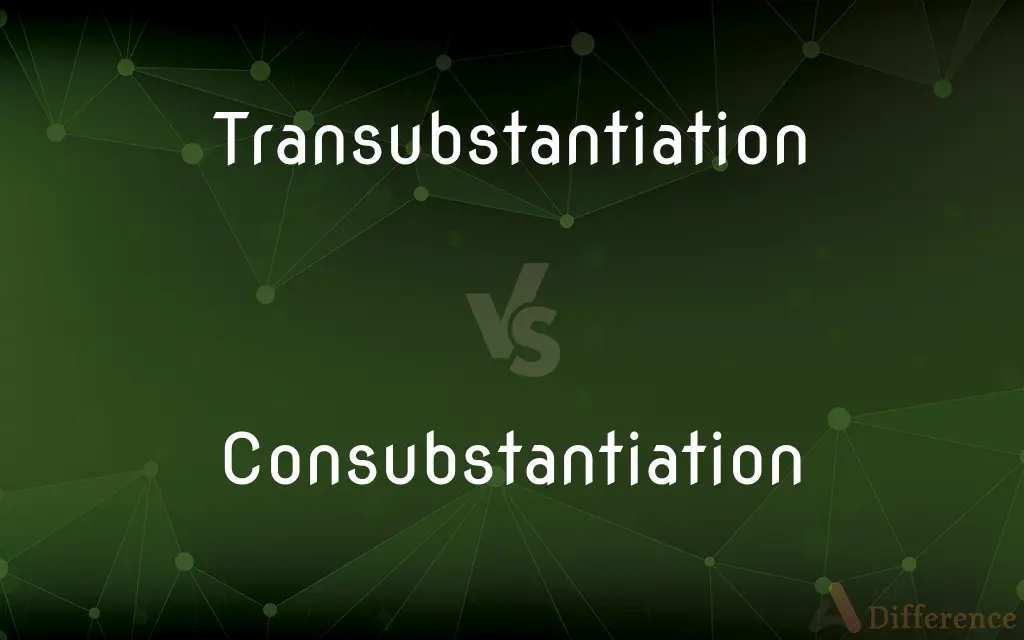Transubstantiation vs. Consubstantiation — What's the Difference?
By Tayyaba Rehman & Fiza Rafique — Updated on March 18, 2024
Transubstantiation involves the bread and wine becoming Christ's body and blood, while consubstantiation holds they coexist with Christ's body and blood.

Difference Between Transubstantiation and Consubstantiation
Table of Contents
ADVERTISEMENT
Key Differences
Transubstantiation, a doctrine central to Roman Catholicism, posits that during the Eucharist, the bread and wine are transformed into the actual body and blood of Jesus Christ, although their appearances remain unchanged. Consubstantiation, associated with some Protestant beliefs, especially Lutheranism, suggests that the body and blood of Christ coexist with the bread and wine without altering their substance.
The concept of transubstantiation is rooted in the philosophy of Aristotle, utilizing the terms 'substance' and 'accidents' to explain how the bread and wine retain their appearance (accidents) while their essence (substance) becomes Christ’s body and blood. Consubstantiation, on the other hand, does not involve such a change in substance; instead, it posits that Christ is present in, with, and under the forms of bread and wine.
Transubstantiation is celebrated during the Mass in the Catholic Church, emphasizing the mystery of faith and the priest’s role in the consecration process. Conversely, consubstantiation reflects a more communal understanding of the Eucharist in Lutheran practice, focusing on the unity of believers with Christ without necessitating a change in the elements’ substance.
The belief in transubstantiation requires acceptance of the Catholic Church’s authority and its interpretation of scripture, particularly Jesus’s words at the Last Supper. Consubstantiation leans on a different interpretation, seeing the presence of Christ in the Eucharist as a sacramental rather than a physical change, aligning with Martin Luther’s teachings.
Debates between these views highlight contrasting theological approaches: transubstantiation emphasizes the mystery and miracle of the Eucharist, requiring faith in the Church’s teachings, whereas consubstantiation values a more direct, scriptural basis for Christ's presence, reflecting differing views on ecclesiastical authority and scriptural interpretation.
ADVERTISEMENT
Comparison Chart
Definition
Transformation of bread and wine into body and blood of Christ
Coexistence of Christ's body and blood with bread and wine
Theological Basis
Aristotelian philosophy, Catholic doctrine
Lutheran tradition, scriptural interpretation
Nature of Change
Change in substance, not appearance
No change in substance, spiritual presence
Role of Priest
Central, performs consecration
Important, but focus on communal aspect
Eucharistic Understanding
Mystery of faith, miracle
Sacramental union, not physical change
Compare with Definitions
Transubstantiation
Emphasizes faith in Church’s teachings.
Transubstantiation reflects deep faith in ecclesiastical authority.
Consubstantiation
Based on a direct scriptural interpretation.
Consubstantiation is supported by a literal reading of Christ’s words at the Last Supper.
Transubstantiation
Involves Aristotelian terms ‘substance’ and ‘accidents’.
The substance changes while accidents remain the same in transubstantiation.
Consubstantiation
Belief that Christ's body and blood coexist with bread and wine.
Lutherans commonly accept the concept of consubstantiation.
Transubstantiation
Focuses on the mystery and miracle of the Eucharist.
The miracle of transubstantiation occurs at the consecration of the bread and wine.
Consubstantiation
Does not involve a change in the substance of the elements.
In consubstantiation, the bread and wine retain their substances.
Transubstantiation
Central to Roman Catholic Eucharist celebration.
Transubstantiation is celebrated in every Catholic Mass.
Consubstantiation
Reflects a communal understanding of the Eucharist.
Consubstantiation emphasizes unity with Christ and believers.
Transubstantiation
Doctrine where bread and wine become Christ's actual body and blood.
Catholics believe in transubstantiation during the Mass.
Consubstantiation
Focuses on the sacramental union.
Consubstantiation teaches a sacramental presence of Christ in the Eucharist.
Transubstantiation
Conversion of one substance into another.
Consubstantiation
Consubstantiation is a Christian theological doctrine that (like transubstantiation) describes the real presence of Christ in the Eucharist. It holds that during the sacrament, the substance of the body and blood of Christ are present alongside the substance of the bread and wine, which remain present.
Transubstantiation
Transubstantiation (Latin: transubstantiatio; Greek: μετουσίωσις metousiosis) is, according to the teaching of the Catholic Church, "the change of the whole substance of bread into the substance of the Body of Christ and of the whole substance of wine into the substance of his Blood. This change is brought about in the eucharistic prayer through the efficacy of the word of Christ and by the action of the Holy Spirit.
Consubstantiation
The doctrine, held by some Christian churches, that the substance of the body and blood of Jesus coexists with the substance of the bread and wine in the Eucharist.
Transubstantiation
In many Christian churches, the doctrine holding that the bread and wine of the Eucharist are transformed into the body and blood of Jesus, although their appearances remain the same.
Consubstantiation
An identity or union of substance.
Transubstantiation
(Roman Catholic) The doctrine holding that the bread and wine of the Eucharist are essentially transformed into the body and blood of Jesus.
Consubstantiation
(Christianity) The actual, substantial presence of the body of Christ with the bread and wine of the sacrament of the Lord's Supper; impanation, as opposed to transubstantiation.
Transubstantiation
(by extension) Conversion of one substance into another.
Consubstantiation
An identity or union of substance.
Transubstantiation
A change into another substance.
Consubstantiation
The actual, substantial presence of the body of Christ with the bread and wine of the sacrament of the Lord's Supper; impanation; - opposed to transubstantiation.
Transubstantiation
The doctrine held by Roman Catholics, that the bread and wine in the Mass is converted into the body and blood of Christ; - distinguished from consubstantiation, and impanation.
Consubstantiation
The doctrine of the High Anglican Church that after the consecration of the Eucharist the substance of the body and blood of Christ coexists with the substance of the consecrated bread and wine
Transubstantiation
The Roman Catholic doctrine that the whole substance of the bread and the wine changes into the substance of the body and blood of Christ when consecrated in the Eucharist
Transubstantiation
An act that changes the form or character or substance of something
Common Curiosities
What is consubstantiation?
A belief associated with Lutheranism that Christ's body and blood coexist with the bread and wine of the Eucharist without changing their substance.
Which denominations believe in transubstantiation?
The Roman Catholic Church upholds the doctrine of transubstantiation.
How do transubstantiation and consubstantiation differ?
Transubstantiation involves a change in substance, while consubstantiation involves a spiritual presence without changing the substance of bread and wine.
What is transubstantiation?
The Catholic doctrine that bread and wine become the actual body and blood of Christ during the Eucharist, with their appearances remaining unchanged.
Which denominations accept consubstantiation?
Lutheranism is most closely associated with the concept of consubstantiation, though the term itself may not be officially used.
How does transubstantiation relate to faith?
It requires deep faith in the Church's teachings and the mystery of the Eucharist.
Is the role of a priest the same in both beliefs?
In transubstantiation, the priest plays a central role in consecration, while in consubstantiation, the focus is more on the communal aspect of the Eucharist.
Can anyone participate in the Eucharist under these beliefs?
Participation requirements vary, with the Catholic Church typically requiring one to be a member in good standing, while Lutheran practice may be more open to all baptized Christians.
How are these doctrines debated within Christianity?
They are central to theological debates on the nature of the Eucharist, reflecting deeper differences in ecclesiology and scriptural interpretation.
How do these doctrines affect the Eucharist celebration?
They influence the understanding and significance of the Eucharist, with transubstantiation emphasizing a miracle of faith and consubstantiation focusing on a sacramental union.
Does consubstantiation deny the real presence of Christ in the Eucharist?
No, it affirms Christ’s real presence but understands it as a coexistence with the bread and wine rather than a transformation.
What is the significance of these doctrines for believers?
They shape the understanding and practice of the Eucharist, reflecting core beliefs about Christ’s presence and the nature of faith.
Why is Aristotelian philosophy important to transubstantiation?
It provides the metaphysical framework for understanding the change in substance without a change in appearance.
How do these beliefs impact the view of the Last Supper?
They offer differing interpretations of Jesus's words at the Last Supper, influencing the theological understanding of the Eucharist.
What role does scriptural interpretation play in consubstantiation?
A direct, literal interpretation of scripture is central to the belief in consubstantiation, emphasizing the words of Jesus.
Share Your Discovery

Previous Comparison
Recreation vs. Play
Next Comparison
Symporter vs. CotransporterAuthor Spotlight
Written by
Tayyaba RehmanTayyaba Rehman is a distinguished writer, currently serving as a primary contributor to askdifference.com. As a researcher in semantics and etymology, Tayyaba's passion for the complexity of languages and their distinctions has found a perfect home on the platform. Tayyaba delves into the intricacies of language, distinguishing between commonly confused words and phrases, thereby providing clarity for readers worldwide.
Co-written by
Fiza RafiqueFiza Rafique is a skilled content writer at AskDifference.com, where she meticulously refines and enhances written pieces. Drawing from her vast editorial expertise, Fiza ensures clarity, accuracy, and precision in every article. Passionate about language, she continually seeks to elevate the quality of content for readers worldwide.
















































